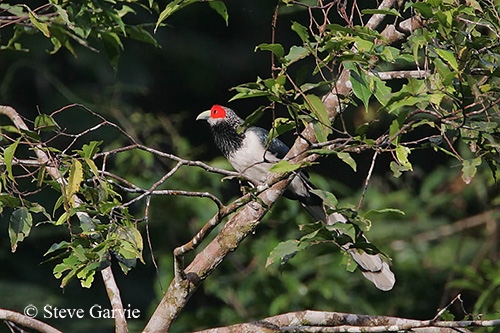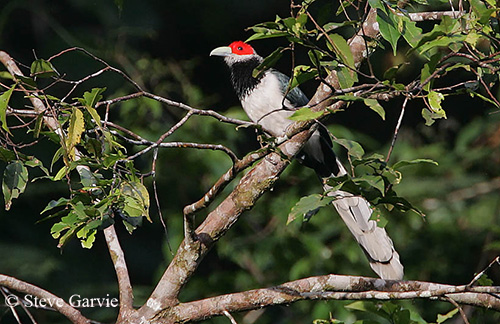
PROTECTION / THREATS / STATUS:
The Red-faced Malkoha is mainly threatened by extensive clearance and degradation of forests, especially in the wet zone, caused by logging, fuel wood collection, conversion for agriculture expansion and tree plantations, gem mining, settlement and fire.
The species is primarily affected by selective logging, involving the reduction of adapted nest-sites. Even the protected forests are regularly degraded and fragmented.
The species is legally protected in Sri Lanka and occurs in several protected parks and reserves.
The population is placed in the band 3,500/15,000 individuals and is suspected to be declining.
The Red-faced Malkoha is currently listed as Vulnerable.
Fr: Malcoha à face rouge
Ang: Red-faced Malkoha
All: Nacktstirnkuckuck
Esp: Malcoha Carirrojo
Ita: Malcoa facciarossa
Nd: Roodwangmalkoha
Sd: rödmaskad malkoha
Photographer:
Steve Garvie
RAINBIRDER Photo galleries
Text by Nicole Bouglouan
Sources:
HANDBOOK OF THE BIRDS OF THE WORLD vol 4 by Josep del Hoyo-Andrew Elliott-Jordi Sargatal - Lynx Edicions - ISBN: 8487334229
Oriental Bird Club - Little-known Oriental bird: Red-faced Malkoha
Wild Parks and Wild Life Sri Lanka
Watha Rathu Malkoha - Red-Faced Malkoha
Wikipedia, the free encyclopaedia
Red-faced Malkoha
Phaenicophaeus pyrrhocephalus
Cuculiforme Order – Cuculidae Family
INTRODUCTION:
The Red-faced Malkoha is a member of the subfamily Phaenicophaeinae in the Cuculidae Family, order Cuculiformes.
The species is found in Sri Lanka of which it is endemic.
It is confined to the Sinharaja Forest Reserve. It favours the dense forests, especially in wet zone, but it also occurs in the dry zone.
It feeds on various insects and small vertebrates such as lizards. It hunts by hopping from branch to branch and sailing from tree to tree.
During the breeding season, it builds a deep, cup-shaped nest within the foliage at subcanopy level. Both adults share the nesting duties.
The Red-faced Malkoha is threatened by clearance and degradation of forests, and it is particularly affected by selective logging involving the loss of adapted nest sites.
The species is currently listed as Vulnerable.
The name “malkoha” comes from the name of this bird in Sinhala Language, one of the two local languages in Sri Lanka. The translation is “Flower-Cuckoo”.

DESCRIPTION OF THE BIRD:
Biometrics:
Length: 40-47 cm
The Red-faced Malkoha has uniformly black upperparts with conspicuous blue and green gloss.
The long, graduated tail is black with broad white tip. The upperwing is similar to the upperparts, with conspicuous green and blue gloss on the flight-feathers.
The underparts are white, contrasting with the black throat and breast. The undertail appears black at the base and distally white.
On the head, the dark feathers of crown, nape, chin, ear-coverts and lower cheeks are flecked with white, sometimes of variable extent according to individuals.
The prominent red mask of the face is not bare, but composed of short, bristly hair-like feathers. It contrasts strongly with the rest of the head, making this bird particularly beautiful.
The large, stout, curved and laterally compressed bill is pale yellowish-green. The lower mandible may appear slightly paler.
The eyes are brown (in male), surrounded by the prominent red mask.
Legs and feet are slaty grey to slate blue.
The female has similar appearance but she has white eyes.
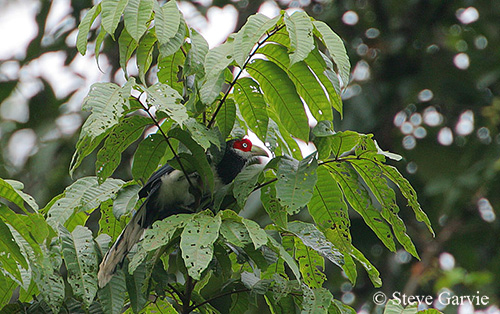
The juvenile has shorter tail, the bill is browner and the red mask is much reduced. Crown, nape and breast are brownish with white flecks on crown, nape and chin. Both flight-feathers and rectrices are browner with more pointed tips.
RANGE:
The Red-faced Malkoha is endemic to Sri Lanka and is mainly found in the south-west part of the island.
HABITAT:
The Red-faced Malkoha is reported from sea-level up to 1,700 metres of elevation. The species probably occurs mainly in the wet zone in SW of Sri Lanka. There, it can find tall, undisturbed forests with dense undergrowth.
The remaining isolated populations within the dry zone in N and E Sri Lanka, occurs in riverine forests.
CALLS AND SONGS: SOUNDS BY XENO-CANTO
The Red-faced Malkoha is often considered as a silent species with sometimes occasional beak rattle and hiss.
When in flight, it produces a low “kaa” or kok”. When landing, it gives a low, whining “kra”. We can also hear a soft “krrr” similar to the purring of a cat, and short, yelping whistles.
The main call is described as “grrr-GRRRRR-GRRRRR-gt’t’t”.
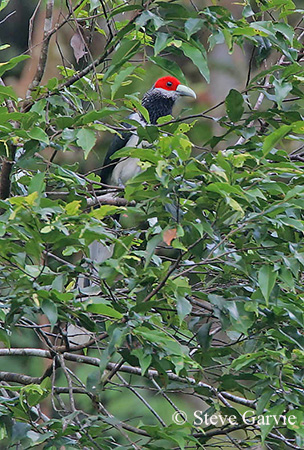
BEHAVIOUR IN THE WILD:
The Red-faced Malkoha was formerly known eating berries on forest trees, but its diet also includes caterpillars and large insects such as mantids, grasshoppers, moths and cicadas. It snatches insects from the leaves in the forest canopy.
It is mainly active in the morning and the afternoon. It forages by hopping from branch to branch and sailing from tree to tree through tangled twigs, creepers and foliage. It is known as a canopy dwelling bird. It comes to the ground for drinking water and bathing during the dry sunny weather.
It often feeds in mixed-species foraging groups of 4 to 9 birds, but also solitary or in pairs.
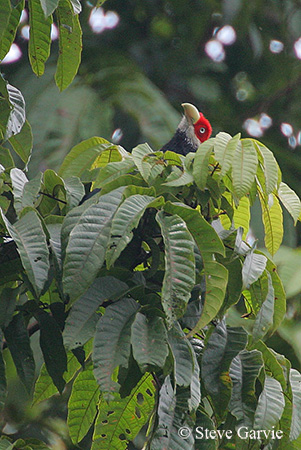
At the beginning of the breeding season, the male is observed following the female while uttering a soft “kree-kree-kree”. The pair can be seen performing short flights from tree to tree, one chasing the other. We can suggest that the bright red mask plays a role during displays.
Both adults build the deep, cup-shaped nest and share the nesting duties.
The Red-faced Malkoha is resident, with possibly some altitudinal movements.
This species has short wings and long, graduated tail, making the flight rather weak, slow and direct. It glides more often than flapping.
The bird prefers to hop from branch to branch to reach a tree top from which it flutters and glides to the forest floor, especially in areas of dense undergrowth. During the flight, the wings produce a musical hum.
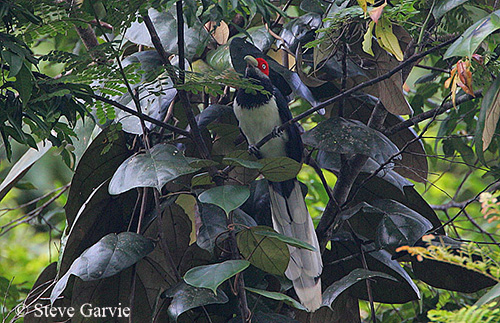
REPRODUCTION OF THIS SPECIES:
The breeding season takes place from January to May, and possibly again in August-September.
Both adults build the nest, a deep cup-shaped structure made of roughly assembled twigs, roots and grass.
From an observation, the nest is described as a stout platform formed of interlocking branching twigs of 15-20 cm long. Then, a thick layer of twigs is placed above this platform, and finally, a layer of Kunumella leaves (family Ebenaceae) is added. The deep cup is lined with fresh leaves.
The nest is usually well-anchored and well-concealed among the foliage, and often built in tree fork, between 9 and 12 metres above the ground, although it is often placed near the ground or in high bushes in forest with dense undergrowth.
The female lays 2 or 3 white eggs with chalky surface. The duration of both incubation and nestling period is unknown. Both parents incubate and feed the young.
No more information.
